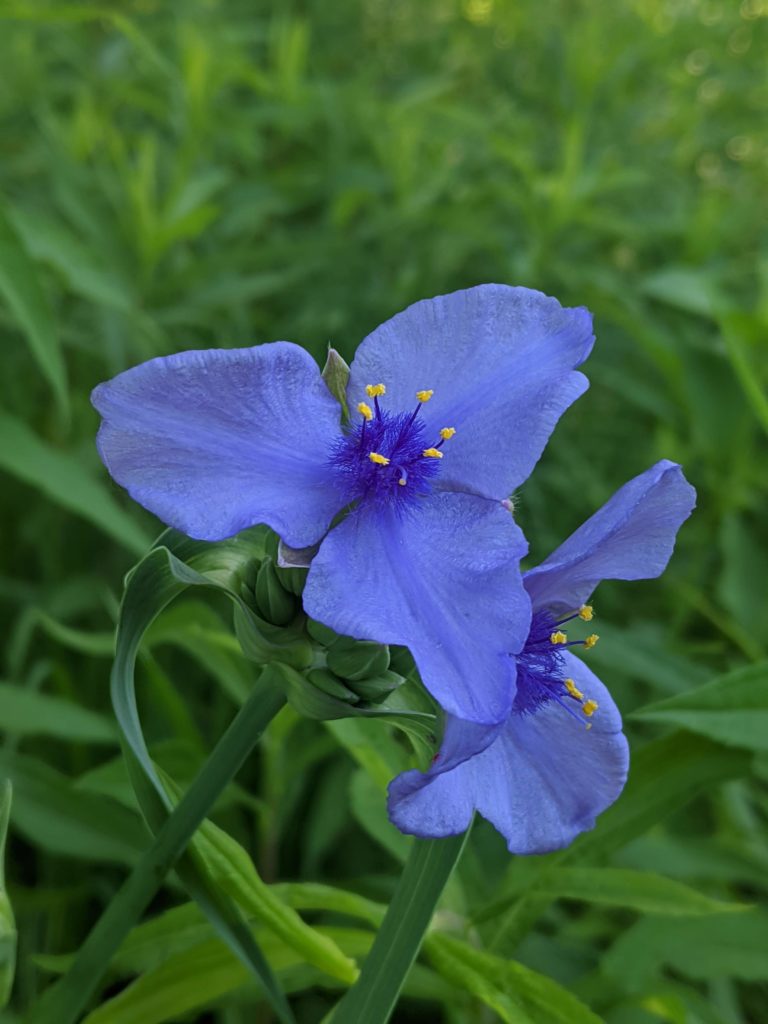Vision

Spiderwort – taken at Big Grove Preserve
The intensity of the mid-morning sun is softened by a thin cloud layer. I’m standing near the base of a steep sandstone ridge, transfixed by a sea of blue. Carpets of wildflowers, caressed by the gentle morning light, has the hillside glowing blue. Light blue-violet patches of wild lupine, medium blue-violet splashes of blue-eyed grass and light blue to blue-violet sheets of spiderwort number in the thousands. The littlest of nearby movement breaks my trance, and I look down to see a small bald head peak up above the short grass. The bald wobbly head reaches skyward in slow motion, and its jaws clamp down on a spiderwort flower. It disappears back into the grass. Soon, the ornate box turtle’s head is back again, and again, continuing its leisurely dining on succulent spiderwort blooms.
I envisioned this scene for this land parcel before we started ecological restoration. I knew this sandstone ridge with deep-sand deposits was part of the historical range of the endangered ornate box turtle. This, along with a few native indicator plant species (such as spiderwort) still hanging on, guided our project goals on a trajectory toward oak savanna and sand prairie.
Today, after decades of restoration, the wildflower display is as depicted in the opening paragraph of this blog post. However, the ornate box turtle is still missing, extirpated long ago. Long before we removed thousands of invasive black locust trees. Long before decades of extensive battles with invasive sweet clover. And long before fire was returned to the land to suppress foreign grasses in favor of native plant species.
Maybe the turtle disappeared in a relatively short time after European settlement, perhaps after the land was prodded by a million cattle hooves? Or maybe it took decades after the introduction of “superior” foreign forage plants that dominated the native ecosystem to push the few surviving native species to the margins? We will likely never know.
It’s important to develop a vision before starting your restoration project. Historical land knowledge (both ecological and land use), modern-day land use constraints, plant and animal species present, available restoration resources, and your desired relationship with your land all play together to shape your vision. The more intimate and knowledgeable you are with/about your land, the better chance your restoration results will reasonably match your vision. Think of your vision as a trajectory – starting at “X” and steering the plant and animal communities toward “Y.” In our case, “X” was a sandy hillside full of invasive black locust trees, and “Y” is an oak savanna and sand prairie. I threw in a stretch goal icon, in this case, the endangered ornate box turtle.
In most cases, shifting a novel ecosystem (an ecosystem dominated by nonnative species) toward an ecosystem of native species, will take enormous resources. It likely took decades, or even a century, to shift native ecosystems into novel ones. The inertia is tremendous, and reversing this process may feel similar to personally stopping a speeding train and pushing it all the way back to the railway station!
A well thought-out vision will give you the strength to endure during long periods of seemingly little progress. Often, visible progress will be exponential, spending a lot of time on the low-magnitude flat part of the curve before the slope grows steeper, representing more gains. It takes time to stop the rapid expansion of invasive species and reduce their numbers, setting the stage for the measured expansion and reintroduction of native species.
Ecological restoration is very much about the process. Little victories along the way help build our endurance and tenacity, but they don’t necessarily measure the success of our restoration. While there is merit in qualitatively measuring the results of our actions, none provide the emotional energy from experiencing a “hillside of blue” in the morning’s gentle sun.
Will the ornate box turtle ever return to our “hillside of blue?” I simply don’t know. Nature is not mine to control.
Turtle or no turtle, it will always be about a lifetime’s journey of discoveries.
Originally published in Environmental Returns.


